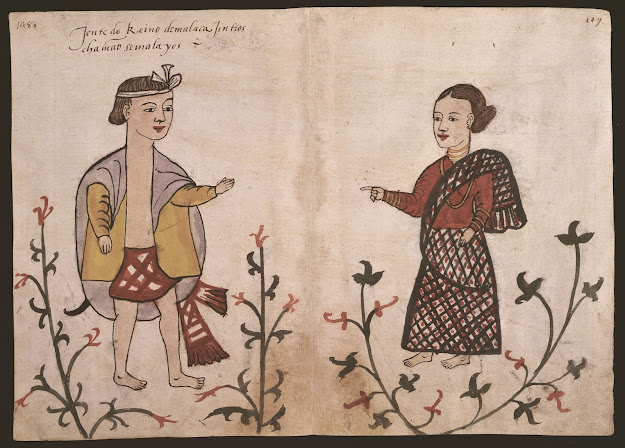Malacca and the Spice Trade
 Portuguese Malacca drawing by Pedro Barreto Resende. In the book Livro das Plantas de Todas as Fortalezas, Cidades" by Antonio Bacaro, Goa 1635
Portuguese Malacca drawing by Pedro Barreto Resende. In the book Livro das Plantas de Todas as Fortalezas, Cidades" by Antonio Bacaro, Goa 1635 "Whoever is lord of Malacca has his hand on the throat of Venice" .-The famous line of the 16th-century Portuguese chronicler Tome Pires highlighting the importance of Malacca (part of Malaysia) to the Spice trade. But long before the arrival of European maritime powers Portugal and Spain in Southeast Asia, spices were already making its way to Europe. From the fabled Spice Islands in the Moluccas (part of Indonesia), Malay and Chinese traders would navigate the dangerous seas to bring the commodities to different ports of the region.
From Malacca, Arab and Indian traders set the prices and take the goods, crossing the waters of the Indian subcontinent and then heading towards important ports of Arabia where caravans would then take the land routes towards the Levant ports. The merchant ships of Venice would then take over from there, distributing the exotic goods to Europe.
From Malacca, Arab and Indian traders set the prices and take the goods, crossing the waters of the Indian subcontinent and then heading towards important ports of Arabia where caravans would then take the land routes towards the Levant ports. The merchant ships of Venice would then take over from there, distributing the exotic goods to Europe.
Malacca, during the height of the spice trade, was the hub of Southeast Asian commerce. Tome Pires mentions the varied ethnicity and races that come and stay in the city for commerce and trade -- Chinese, Arabs, Siamese, Turks. And also a group of people called the "Lucoes" (from Luzon).
Gentile people of Malacca - Malayos. Anonymous author. 16th Century illustration from "Casanata Codex"
The Portuguese wanted full control of the sea routes from their colony in Goa (India) to the Moluccas, so in 1511, Alfonso de Albuquerque with a force of 1,200 men and around 20 ships attacked the city and defeated the Muslim its rulers.
Malacca shortly after it's conquest by the Portuguese, by Gaspar Correia in his 'Lendas da Índia'. 16th Century
Among the soldiers belonging to Albuquerque force was an officer who, after the conquest of Malacca, returned to Europe and began corresponding with his friend Francisco Serrão, who was living in the Moluccas. Serrão, also a veteran of the Malacca campaign, sailed and stayed in the Moluccas after the Portuguese took Malacca. Their letters became a blueprint for an expedition quite different from other undertakings.
The officer had returned to Portugal with a Malay slave he named "Enrique." In less than a decade, he would sail again to the Spice Island. The man was no other than Ferdinand Magellan.
Among the soldiers belonging to Albuquerque force was an officer who, after the conquest of Malacca, returned to Europe and began corresponding with his friend Francisco Serrão, who was living in the Moluccas. Serrão, also a veteran of the Malacca campaign, sailed and stayed in the Moluccas after the Portuguese took Malacca. Their letters became a blueprint for an expedition quite different from other undertakings.
The officer had returned to Portugal with a Malay slave he named "Enrique." In less than a decade, he would sail again to the Spice Island. The man was no other than Ferdinand Magellan.
The ruins of the old gate of the Portuguese fortress at Malacca -- "A Famosa" (The famous), Believed to be the oldest European made structure in Southeast Asia. Built after the Portuguese conquered Malacca in 1511. (Wiki )





.png)


Comments
Post a Comment